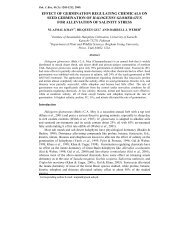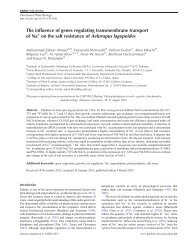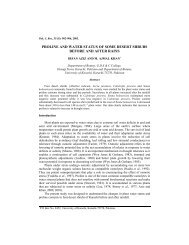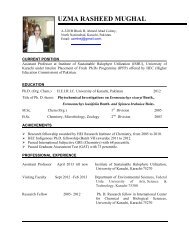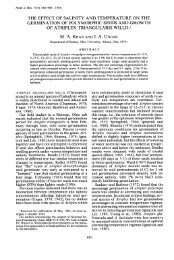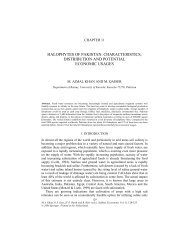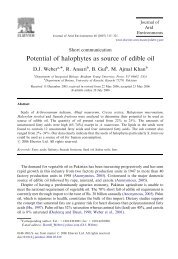Halophytes as Medicinal Plants - ResearchGate
Halophytes as Medicinal Plants - ResearchGate
Halophytes as Medicinal Plants - ResearchGate
Create successful ePaper yourself
Turn your PDF publications into a flip-book with our unique Google optimized e-Paper software.
334 336 338<br />
Urbanisation, Land Use, Land Degradation and Environment<br />
DISTRIBUTION<br />
<strong>Halophytes</strong> are found in a range of environmental conditions depending on their<br />
ability to tolerate various combinations of salts in the substrate (Song et al., 2008) and<br />
may be grouped in various ways such <strong>as</strong> into co<strong>as</strong>tal, near co<strong>as</strong>tal and inland species<br />
depending on the proximity to the open sea or according to the type of habitat they<br />
occupy such <strong>as</strong> salt desert, salt flat or salt marsh plants.<br />
RESULTS AND DISCUSSION<br />
<strong>Halophytes</strong> are adapted to tolerate harsh saline and arid conditions by<br />
synthesizing a number of active chemicals to maximize their fitness, many of which<br />
are a source of potent medicine against a number of chronic ailments. Co<strong>as</strong>tal<br />
environments were reported to be more stressful than inland due to higher soil<br />
salinity, greater light intensity and more frequent diurnal and se<strong>as</strong>onal climatic<br />
conditions (Gulzar and Khan, 1998). Numerous reports have documented the<br />
traditional uses of medicinal plants in rural and tribal are<strong>as</strong> all over the world <strong>as</strong> a<br />
successful home remedy against different ailments (Hamburger and Hostettmann,<br />
1991; Hammiche and Maiza, 2006; Hussain et al., 2006).<br />
TRADITIONAL USES<br />
The ethnobotanical data collected from different sources covers 7 health related<br />
conditions i.e., digestive, skin, respiratory, pain, fever and toothache, genito-urinary<br />
and others. A summary of the different ethnobotanical uses of 45 documented species<br />
(Table 1) and their percent distribution with respect to type of dise<strong>as</strong>e condition<br />
(Table 2) is presented here. In almost all c<strong>as</strong>es whole plants or plant parts are used <strong>as</strong><br />
a cure for various illnesses which indicates the presence of beneficial chemicals.<br />
DIGESTIVE CONDITIONS<br />
Twenty four percent of the species reported here are used <strong>as</strong> purgatives,<br />
carminatives and <strong>as</strong> anti-helmintics in the treatment of digestive disorders like<br />
stomach pain, vomiting, diarrhea (Fig 1). Acacia nilotica L., Citrullus colocynthis L.<br />
and Ipomoea pes-caprae (L.) Swt. are the most frequently used species. Chenopodium<br />
album L. and Digera muricata (L.) Mart. are used to treat constipation and bowel<br />
movement. Haloxylon stocksii (Boiss.) Benth. & Hook. and Portulaca oleracea L. are<br />
used for the treatment of stomach ache (Ilahi 2008; Husain et al. 2008), for ulcer<br />
(Ilahi 2008; Shafi et al. 2001) and for vomiting and g<strong>as</strong>tric trouble (Agoramoorthy<br />
2008, Shafi et al. 2001, Qureshi and Bhatti 2008, Savithramma et al. 2007, Ilahi<br />
2008). Capparis decidua Forssk. is a popular carminative (Ilahi 2008) while Withania<br />
somnifera (L.) Dunal and Zygophyllum simplex L. are used to cure helminthi<strong>as</strong>es<br />
(Husain et al. 2008; Hammiche and Maiza 2006). Salvadora oleoides Decne. is also<br />
used <strong>as</strong> a purgative (Shafi et al. 2001) while Rhizophora mangle L. is used to treat<br />
diarrhoea (Coelho-Ferreira 2009).<br />
SKIN CONDITIONS<br />
Skin conditions account for 15% of plant species listed (Table 1; Fig 1). Cleome<br />
brachycarpa Vahl. and Cynodon dactylon ( L.) Pers. are frequently cited for the<br />
treatment of wounds, itching and inflammations. Fagonia indica Burm. f. and<br />
Heliotropium strigossum Willd. are also used in the treatment of wounds (Shafi et al.




